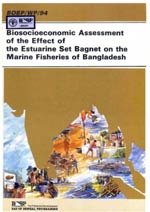|
PREFACE
The estuarine set bagnet (ESBN) fishery of
Bangladesh is one of the country’s niost important
traditional fisheries and a large population of small-scale
fisherfolk have been dependent on it for a long time. In the last
two decades, the introduction and rapid expansion of the bottom
trawl fishery and of shrimp culture have contributed to problems
of interaction and competition among the fisheries which exploit
the same penaeid shrimp and demersal finfish stocks. The
traditional, but less efficient, ESBN fishery has not only become
vulnerable, being likely to be affected by other fisheries, but
may also be destructive to small penaeid shrimp and some of the
finfish resources that these other fisheries exploit. The
Department of Fisheries, Bangladesh, decided to investigate this
issue and the Bay of Bengal Programme (BOBP) was requested to
assist. The study was funded by the United Nations Development
Programme (UNDP). Bioeconomic and socioeconomic surveys were
undertaken in 1989/90 and a National Seminar was held in January
1992 to discuss the results.
Because of the interactive nature of many of
the marine fisheries, it was necessary, for the assessment and
management of any one fishery, to consider the other fisheries
exploiting the same resources. Therefore, in addition to the
estuarine set bagnet fishery, the fisheries employing marine set
bagnets (MSBN), trammelnets (TRN), beach seines (BS), bottom
longlines (BLL) and trawlnets (TWL), as well as shrimp
fry-collection using pushnets (PN) and dragnets (DN), were
investigated. These studies have been documented separately in
BOBP working papers BOBP/WP/89 Studies of Interactive Marine
Fisheries of Bangladesh and BOBP/WP/90 — The Socioeconomic
Condition of the Estuarine Set Bagnet Fisherfolk in Bangladesh.
The present paper is based on the results and findings of these
publications and assesses the biosocioeconomic impact of the ESBN
fishery on the other marine fisheries of Bangladesh. The working
papers mentioned provide additional information on the respective
fisheries.
|
